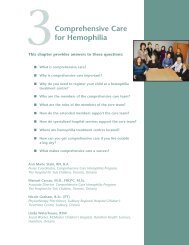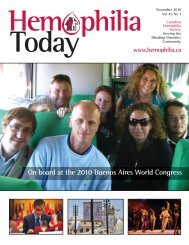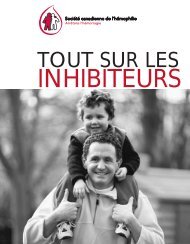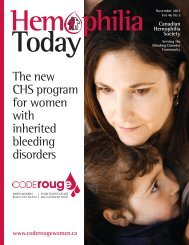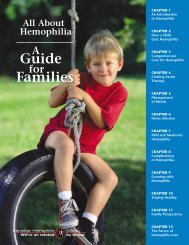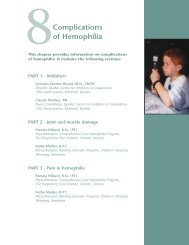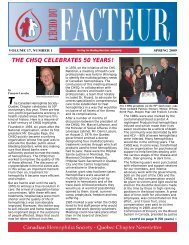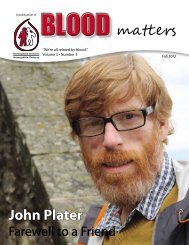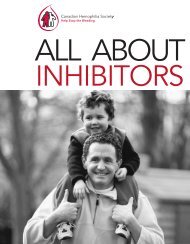Download
Download
Download
- No tags were found...
Create successful ePaper yourself
Turn your PDF publications into a flip-book with our unique Google optimized e-Paper software.
HEMOPHILIA TODAY PHYSICAL FITNESSSUMMER 2002AND BLEEDING DISORDERS19Cycling (stationary, tricycle or regular -if agile/mature enough) is a good way ofstrengthening the lower extremities andproviding cardiovascular benefits. Usually,the lower extremities (especially theankles) are placed under less weightbearingstress in cycling, due todistribution of body weight on thepelvis/seat, hands and feet. Cycling doesrequire approximately 100 degrees offlexion at the hips and knees though.Therefore, proceed with caution and thephysiotherapist’s guidance, especially inthe presence of target joints, recent bleedsor other injuries. Also, remember toalways wear a helmet and to obtainadvice on proper positioning of seat, feet,handlebars, etc.*Of all the activities mentioned inthis article, regular cycling outdoors hasthe greatest risk of potential injury.Therefore extreme caution and/orsupervision are needed if the cyclist isnot proficient. If ANY doubt remainsafter the team considers all the risks andbenefits, it would be prudent to considerstationary biking instead.*Walking may be indicated for certainpeople. It does require relatively healthyknees and ankles. Proper shoes withadequate support and control arerecommended. If necessary, yourphysiotherapist might suggest the lace-ontype of ankle-support braces. Be verycareful on uneven surfaces (trails) toprevent ankle sprains or falls.Tai chi provides benefits to thepostural muscles of the trunk, hips,shoulders, and helps to improve generalbalance and coordination. Because Tai Chiis done very slowly, there is little risk ofinjury from sudden movements. However,it also requires relatively healthy lowerlimbs.Finally, your physiotherapist may offeryou a personalized fitness/exerciseprogram. He/she may prescribeprogressive strengthening with freeweights, resistive elastic bands, springs, orbody weight, coupled with flexibilityexercises and possibly proprioceptive(balance) exercises. If necessary, theseexercises can be done within restrictedranges of motion. This may be analternative for certain people with severaltarget joints who are unable or unwillingto perform any of the other activitiesmentioned.In closing:• In the presence of inhibitors, oneshould think in terms of “physicalactivities” instead of “sports”.• Choose your activity following athorough, open discussion among you,your family and your health care team,and then maintain regular contact withyour physiotherapist.• Refrain from high-velocity throwingor kicking to prevent possible synovialimpingement and bleeding.• Progress your activity intensity andduration levels slowly and cautiously, andunder the guidance of yourphysiotherapist.• Be prepared to use all recommendedprotective devices (braces, taping, helmets,etc.) and incorporate modifications in theactivity to minimize the risk of injuries.• Be alert to the early warning signs ofbleeds and get proper treatmentimmediately.Enjoy performing your chosen activitysafely!REFERENCES1. Anderson A, Holtzman TS, Masley J. Physical TherapyIn Bleeding Disorders. National Hemophilia Foundation:2000.2. Can a Person With Hemophilia Play Sports? CanadianHemophilia Society web site.«www.hemophilia.ca/en/2.1.10.html#2»3. Jones PM, Buzzard BM, Heinjen L. Go For It: Guidelineson Physical Activity and Sports for People withHaemophilia and Related Diseases. World Federation ofHaemophilia: 1998.ProfileKathy Mulder,PhysiotherapistOver the last 11 years, popular features ofHemophilia Today have been BarryIsaac’s profiles of hemophilia caregivers—physicians, nurses, social workers andphysiotherapists. Just before his death inJuly, Barry interviewed Kathy Mulder,physiotherapist with the HemophiliaTreatment Centre at the Children’sHospital in Winnipeg, and Guest Editor ofthis issue of Hemophilia Today. Barrydidn’t have time to finish his article, andwe won’t have the pleasure of his fineprose. However, with Kathy’s help, we haverecreated, as accurately as possible, theinterview that Barry did with her beforehis death. Here is Barry’s final “Profile”.Hemophilia Today: What made youchoose physiotherapy as a career?Kathy Mulder: I wanted to do somethinginvolving medicine. I looked at nursingand medical studies, but decided thatphysiotherapy was more to my liking. Isaw it as a very hands-on and practicalway to help with positive outcomes.People are usually starting to feel betterwhen we see them.Hemophilia Today: First, where did youdo your training?Kathy Mulder: I graduated from theUniversity of Manitoba. I hope youaren’t going to ask me when!



